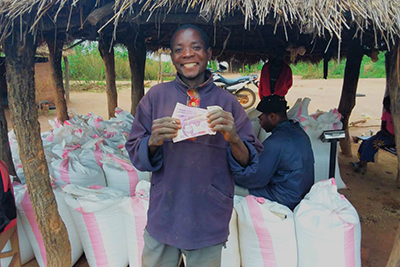
For several years now, elements of NCBA CLUSA’s PROMAC II project, funded by the Norwegian Government, have been moving toward digitalization. However, with its restrictions on travel and face-to-face contact with farmers in Mozambique, COVID-19 has made digital communication essential—especially during harvest and commercialization season.
Meanwhile, project field staff has been tracking sales prices for key commodities—including maize, soybean, cowpea, sugar bean, pigeon pea, sesame and peanut—and using this information to advise smallholders farmers on how best to market and sell their product. This year, PROMAC II has taken that support to the next level, by digitally sharing this information with farmers.
Each week, PROMAC II’s Field Assistants collect the prices paid for each main commodity at community buying posts—small and usually temporary buying hubs established by large traders and their intermediary networks who receive farmers’ product and check its weight and quality before offering farmers on-the-spot payment. Their convenient location in the heart of rural communities and the promise of immediate payment for even the smallest quantity make them by far the most commonly used point of sale for smallholder-produced commodities.
PROMAC II Field Assistants collect the buying post prices throughout the week, calculate an average for each district, and feed this data to Agribusiness Unit Advisors who then, with support from PROMAC II’s Monitoring and Evaluation Team, analyze trends and produce a weekly price report.
The report shows market trends and average sales prices, provides basic market intelligence, advises farmers on what to do with their product (store, sell now or sell later when the price goes up), indicates the main community buyers operating in the area who will pay a premium for buying in bulk and, where appropriate, links farmer groups directly to buyers.
As PROMAC II transitions to more digital communication in the coming years, the project anticipates an increase in technologies such as smart phone apps, but for now, the most effective and immediate solutions come from technologies that farmers are already acquainted with and can access right now.
This makes community radio the most obvious solution—31 and 40 percent of households own a radio in Zambézia and Manica provinces, respectively. In April, PROMAC II’s Field Assistants, Agribusiness Unit and Communications Teams came together to make this happen. Under the project’s coordination, each of the existing PROMAC II-supported interactive community radio programs (which already share good agricultural practices and conservation agriculture techniques) ends with a regular price report, with messages broadcast via five radio stations three times a day in both Portuguese and local languages.
In addition, Agribusiness Unit staff provide an even lower-tech solution by distributing a printed version of the report to local inputs retailers and commodity aggregators who display it on their shop walls—a simple but effective solution to ensuring that farmers know that the price they are being offered is fair.
What’s more, from the end of May onward, PROMAC II will also experiment with disseminating prices via another key technology—text message—using the Frontline SMS system to send weekly, or even more regular, price updates directly to a potential audience of over 30,000 PROMAC II supported farmers via their mobile phones, at the touch of a button.


